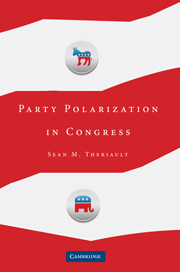Book contents
- Frontmatter
- Contents
- Acknowledgments
- 1 Party Polarization in the U.S. Congress
- PART I BUILDING BLOCKS FOR EXPLAINING PARTY POLARIZATION
- PART II CONSTITUENCY CHANGE
- 4 Redistricting
- 5 The Political and Geographic Sorting of Constituents
- 6 Extremism of Party Activists
- PART III INSTITUTIONAL CHANGE
- Bibliography
- Index
5 - The Political and Geographic Sorting of Constituents
Published online by Cambridge University Press: 05 September 2012
- Frontmatter
- Contents
- Acknowledgments
- 1 Party Polarization in the U.S. Congress
- PART I BUILDING BLOCKS FOR EXPLAINING PARTY POLARIZATION
- PART II CONSTITUENCY CHANGE
- 4 Redistricting
- 5 The Political and Geographic Sorting of Constituents
- 6 Extremism of Party Activists
- PART III INSTITUTIONAL CHANGE
- Bibliography
- Index
Summary
Michigan's Livingston County is strategically situated. It is less than an hour's drive from both the state capitol in Lansing and the auto manufacturing international headquarters in Detroit. Even as the industry in Michigan has shed high-paying low-skilled jobs, Livingston County's population has experienced growth almost unrivaled in the state, increasing more than 166 percent over the past 30 years. In contrast, Wayne County, where much of Detroit is located, has lost almost 23 percent of its population over the same time period.
Livingston and Wayne are not only experiencing divergent population changes, but also as the residents politically sort themselves, move in, and leave the area, the demographics of these counties have similarly diverged. Wayne was 27.7 percent African American in the 1970s. In the 2000 census, that percentage increased almost 15 percentage points to 42.2 percent. Although the median household income in Wayne County has tripled over the 30 years, its residents went from earning about 1 percent more than Michigan's median to earning nearly 9 percent less. Although Livingston's black population has not changed much (in the 2000 census, it was still less than one-half of 1 percent), the residents' increase in earnings has nearly doubled those in Wayne. Whereas Livingston's median household earned almost 9 percent more than Michigan's median in 1970, it now earns more than 50 percent more than the state's median.
- Type
- Chapter
- Information
- Party Polarization in Congress , pp. 85 - 108Publisher: Cambridge University PressPrint publication year: 2008



